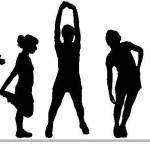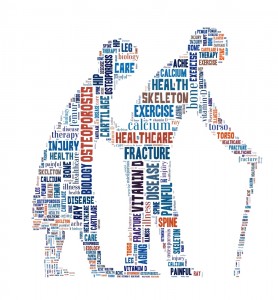
Today we are continuing our theme of evidence related to physical activity and exercise for people with musculoskeletal conditions. The Musculoskeletal Elf has an interest in exercise as a therapeutic intervention and so last year we wrote a Cochrane review with the aim of examining the effectiveness of exercise interventions in preventing bone loss and fractures in postmenopausal women. As we discussed in a previous blog there is a difference between physical activity and exercise.

The high prevalence and staggering costs of osteoporotic-related fractures in postmenopausal women means prevention and management of this disease is important.
Osteoporosis is a condition resulting in an increased risk of skeletal fractures due to a reduction in the density of bone tissue. Treatment of osteoporosis typically involves the use of pharmacological agents. In general it is thought that disuse (prolonged periods of inactivity) and unloading of the skeleton promotes reduced bone mass, whereas mechanical loading through exercise increases bone mass. Exercise interventions prescribed for people with osteoporosis or to prevent osteoporosis are typically those that stress or mechanically load bones (when bones support the weight of the body or when movement is resisted for example when using weights) and include aerobics, strength training, walking and tai chi.
The high prevalence and staggering costs (Burge 2007) of osteoporotic-related fractures in postmenopausal women means prevention and management of this disease is important.
Here’s what the Musculoskeletal Elf did
We searched several electronic databases up to December 2010 and included forty-three RCTs with 4320 participants. Our major outcome of interest was number of incident fractures: vertebral and non-vertebral (hip and wrist) and secondary outcomes included bone mass including BMD, bone mineral content (BMC), or calcium bone index (CaBI) immediately postintervention and at follow-up. We assessed risk of bias for each included study using the Cochrane Collaboration’s ‘Risk of bias’ tool.
Here’s what the Musculoskeletal Elf found
- The most effective type of exercise intervention on bone mineral density (BMD) for the neck of femur appears to be non-weight bearing high force exercise such as progressive resistance strength training for the lower limbs (MD 1.03; 95% confidence interval (CI) 0.24 to 1.82).
- The most effective intervention for BMD at the spine was combination exercise programmes (MD 3.22; 95% CI 1.80 to 4.64) compared with control groups with a change of over 3% compared with control groups.
- Fractures and falls were reported as adverse events in some studies. However the risk of fracture across all exercise groups was not significantly different than that in controls with 4 more women out of 100 who did not exercise sustaining a fracture (absolute difference 4%) (odds ratio (OR) 0.61; 95% CI 0.23 to 1.64).
- These exercise types should be considered as preferred interventions in clinical practice, however, it remains unclear as to what constitutes an optimal exercise programme.
The Musculoskeletal Elf’s summary
Our results suggest a relatively small statistically significant, but possibly important, effect of exercise on bone density compared with control groups. Exercise has the potential to be a safe and effective way to avert bone loss in postmenopausal women.
The Musculoskeletal Elf’s views
 Overall, the quality of the reporting of studies in the meta-analyses was low, in particular in the areas of sequence generation, allocation concealment, blinding and loss to follow-up.
Overall, the quality of the reporting of studies in the meta-analyses was low, in particular in the areas of sequence generation, allocation concealment, blinding and loss to follow-up.
The situation is further compounded in that many factors influence the effectiveness of exercise interventions including:
-
attendance;
-
adherence to the programme;
-
accuracy of the assessment system;
-
type of exercise; and
-
duration, intensity, frequency and length of exercise programme.
Clearly these factors were variable in the included studies in this review. We also categorised the exercise interventions into the following six categories.
-
Static weight bearing (SWB); including single leg standing.
-
Dynamic weight bearing exercise low force (DWBLF); including walking and Tai chi.
-
Dynamic weight bearing exercise high force (DWBHF); including jogging, jumping, running, dancing and vibration platform.
-
Non-weight bearing exercise low force (NWBLF); e.g. low load, high repetition strength training.
-
Non-weight bearing exercise high force (NWBHF); e.g. progressive resisted strength training.
-
Combination (COMB); more than one of the above exercise interventions.
Please note that these are the views of the Musculoskeletal Elf and report the findings of our Cochrane review. Cochrane reviews follow an established methodology and rigour is maintained through the development of a published peer reviewed protocol and extensive peer review of the final review.
Questions
- Do you prescribe exercise for postmenopausal women?
- What do you think to our categories of exercise?
- What factors do you think could influence the effectiveness of exercise?
Links
- Howe TE, Shea B, Dawson LJ, Downie F, Murray A, Ross C, Harbour RT, Caldwell LM, Creed G. Exercise for preventing and treating osteoporosis in postmenopausal women. Cochrane Database of Systematic Reviews 2011, Issue 7. Art. No.: CD000333. DOI: 10.1002/14651858.CD000333.pub2.
- Higgins JPT, Altman DG, Sterne JAC. Assessing risk of bias in included studies. In: Higgins JPT, Green S editor(s). Cochrane Handbook for Systematic Reviews of Interventions Version 5.1.0 [updated March 2011]. The Cochrane Collaboration, 2011: Available from www.cochranehandbook.org.
- Burge R, Dawson-Hughes B, Solomon DH, Wong J B, King A, Tosteson A. Incidence and Economic Burden of Osteoporosis-Related Fractures in the United States, 2005-2025. Journal of Bone and Mineral Research 2007;22(3):465-475.

Exercise for osteoporosis in postmenopausal women http://t.co/74lk2Sn7cM
“@MSK_Elf: Exercise for osteoporosis in postmenopausal women http://t.co/XB1axBX3QS” #CochraneEvidence blog
Review of exercise for preventing osteoporosis in postmenopausal women, by Musculoskeletal Elf. http://t.co/VxmjGpXCsj
Blog #Exercise for #osteoporosis in postmenopausal women http://t.co/xaznkzKy9f
blog #osteoporosis postmenopausal women and #exercise @physiowizz @PTHSN http://t.co/xaznkzKy9f
#Exercise #osteoporosis postmenopausal women blog @arthritisdigest http://t.co/xaznkzKy9f
@MSK_Elf @ArthritisDigest I’ve posted in our @womenshealthFB FB group, many thx Gerard
@WeNurses #Exercise for #osteoporosis in postmenopausal women http://t.co/xaznkzKy9f
The Musculoskeletal Elf shares it’s tips on Osteoporosis Exercise in postmenopausal women http://t.co/XOGdsnPnhX via @sharethis
Daily exercise helps you to improve your energy level and strength and this post clearly indicates the exercise benefits for people with musculoskeletal conditions
.@MSK_Elf many thanks for an excellent summary and questions- great link! Best wishes Ann